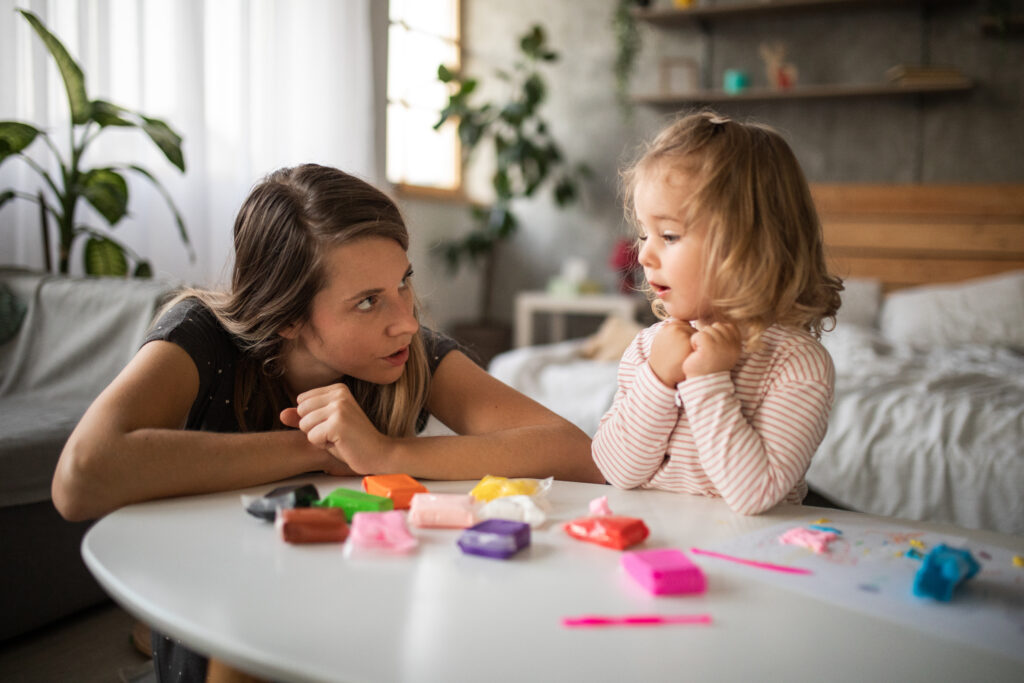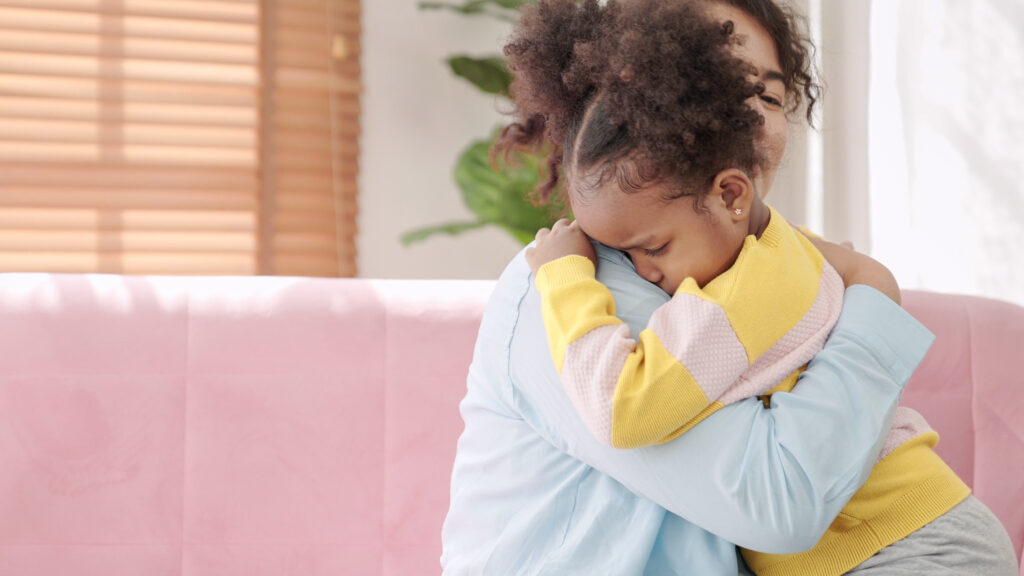Taming toddler tantrums and preschooler protests can be smoother than you think. Dive into our top discipline strategies for toddlers that promise more giggles and fewer frowns!
Talk It Out

Talking things out with an unhappy toddler might sound a bit like negotiating with a tiny, opinionated CEO. But it’s actually one of the most effective discipline strategies.
By engaging them in conversation, you’re acknowledging their feelings and perspectives, making them feel heard and valued. It’s a simple yet powerful tool to redirect their energy.
The next time your toddler is on the brink of a meltdown, kneel down to their level and use calm, straightforward language to talk it out.
Cool Down Corner

Imagine transforming a toddler’s meltdown into a serene moment of reflection. That’s the magic of a Cool Down Corner, a key discipline strategy for toddlers.
Creating a Cool Down Corner is like setting up a mini-retreat for your little one. Stock it with soft pillows, comforting toys, and books.
The beauty of a Cool Down Corner lies in its effectiveness. It empowers toddlers to recognize and manage their emotions independently, a priceless skill for their future.
Praise the Good

When it comes to discipline strategies for toddlers, nothing beats the power of positive reinforcement. It’s a simple yet effective way to encourage good behavior.
By lavishing praise on them, we’re essentially telling our little ones, “Hey, what you just did is awesome, and I want to see more of it.”
Ever noticed how toddlers beam with pride over the smallest achievements? That’s because they thrive on approval! That’s what makes this such an effective strategy.
Time-In Technique

Switching gears from traditional discipline, the Time-In Technique is a gem among discipline strategies for toddlers. It’s all about turning a typical timeout into a moment of togetherness.
Instead of sending your toddler to the corner for a timeout, you sit with them and tackle those big feelings together. This discipline strategy teaches emotional intelligence.
The beauty of the Time-In Technique lies in its approach to understanding rather than punishing. It’s a way to navigate the seas of toddler emotions with empathy.
Power of Choice

When it comes to preemptive discipline strategies for toddlers, offering choices is a simple trick that turns a potential showdown into a win-win for both of you.
It’s all about avoiding those power struggles that can lead to a meltdown in the first place. Offering choices is one of the most powerful ways to do that.
For example, give your child the choice between putting their toys away now or after snack time. They’ll feel more in control, which means fewer tantrums.
Follow Through

Here’s a nugget of wisdom: setting clear expectations and following through is key. It teaches your little explorer that every action leads to a predictable outcome.
Think of discipline strategies for toddlers as your toolkit for building a bridge between actions and consequences. It’s not about punishment, but guidance.
By consistently applying these strategies, you’re laying down the stepping stones that help your toddler understand the world around them. This clarity is essential for developing brains.
Routine Rules

Ever wonder why your little ones seem to thrive on repetition? It’s because a consistent daily routine offers them a world of security and predictability.
Incorporating discipline strategies for toddlers within this routine doesn’t just keep the peace; it fosters a sense of safety and belonging. It’s a subtle yet powerful discipline strategy.
Routines help team toddlers about expectations and consequences in a non-threatening way. This structure helps them understand their boundaries, making it easier for them to navigate their emotions.
Emotion Coaching

Emotion coaching isn’t just a fancy term; it’s a pivotal part of discipline strategies for toddlers. By teaching our little ones to name what they’re feeling, we’re giving them a superpower.
Recognizing emotions is the first step to managing them! It’s all about helping your child understand and manage their emotions effectively. Start by empathizing with their feelings.
Then help them label what they’re feeling, discuss why they might feel that way, and explore some appropriate responses to the feeling. Focus on teaching rather than punishing.
Distraction Works

One of the most effective discipline strategies involves the art of distraction. It’s like magic: one minute they’re on the brink, and the next, they’re giggling.
Incorporating this strategy into your discipline toolkit can make a world of difference. It’s about creatively redirecting their attention to something constructive, which can be a game-changer.
This technique not only prevents a potential tantrum but also teaches toddlers to shift their focus and adapt to new situations. It’s an essential skill for their future.
Model Patience

In the whirlwind of parenting, mastering discipline strategies for toddlers can feel like trying to solve a Rubik’s Cube blindfolded. But here’s a secret ingredient: patience.
By modeling patience, we teach our little ones the art of waiting. It’s all about showing them that not everything needs to happen right this second.
Remember the last time you were stuck in traffic with a toddler in the backseat? Think of it as a golden opportunity to demonstrate patience.
Listening Ears

Imagine trying to share something important, but the listener is distracted. Frustrating, right? Toddlers feel the same. Try giving them your undivided attention when they’re upset.
Truly listening to your toddler shows them they’re valued and understood. Plus, it’s the first step in cultivating a lifelong habit of effective communication.
This approach not only diffuses tantrums but also teaches toddlers how to express themselves calmly and clearly. It’s a fundamental aspect of discipline for toddlers.
Limit Setting

Setting clear, reasonable limits is akin to drawing a map that guides your toddler or preschooler to understand boundaries, making your life a tad easier.
Ever tried telling a toddler not to touch something, only to find them doing exactly that seconds later? It’s a classic scenario in many households.
Think of limit setting as the secret ingredient in your parenting toolkit. It’s not just about saying “no.” It’s about teaching your little explorers why certain boundaries exist.
Creative Outlets

Exploring creative outlets is an essential part of respectful discipline. Through artistic activities, toddlers learn to focus their energy and express themselves in constructive ways.
Try turning a tantrum into a dance party! Cranking up some tunes and letting loose helps toddlers express themselves in a space where they’re free to be themselves.
Incorporating storytelling into your discipline strategies for toddlers can also work wonders. Encourage them to tell their own creative stories to better understand their emotions.
Nature’s Nurture

Ever noticed how a simple walk outside can turn a toddler’s frown upside down? It’s not magic, it’s nature! Integrating outdoor time for toddlers can work wonders.
Getting out in nature can help give your toddler or preschooler a fresh perspective and a chance to burn off that boundless energy. Sometimes, that’s all that’s needed.
By incorporating nature into your discipline strategies for toddlers, you’re not just redirecting their attention; you’re nurturing their curiosity and fostering a love for the environment.
Sleep Tight

Believe it or not, one of the most effective discipline strategies for toddlers involves getting them into bed at around the same time every night.
Consistency is key, and a cozy bedtime routine can work wonders for their mood and behavior. That’s why gentle, consistent sleep training is so essential.
Remember, a well-rested toddler is a happy toddler. Establishing a bedtime routine isn’t just about discipline; it’s about creating a safe, comforting end to their day.
Tech Time-Out

Implementing tech time-outs isn’t just about taking gadgets away; it’s one of the most effective discipline strategies for toddlers. It’s a gentle nudge towards greater exploration.
It encourages them to explore the world with their tiny hands instead, sparking their imagination and creativity without the need for digital stimuli.
Encouraging physical play over screen time not only boosts their physical health but also improves their mood and sleep. And that means fewer tantrums.
Lead by Example

Remember, little eyes are always watching! By handling challenging moments with calmness and respect, you’re setting the stage for your toddler to do the same.
It’s like being a superhero, where your power is setting a positive example. Think of each day as a live demo in the art of cool, collected behavior.
The best way to guide your little one is to show them how it’s done. So next time you’re faced with a toddler-sized challenge, remember, you’re the role model!
Mindful Moments

In the whirlwind of parenting, discipline for toddlers can sometimes feel like navigating a ship in a storm. But what if we could find our calm?
Enter mindfulness. By weaving in mindful moments with your toddler, you’re not just calming the storm, but also teaching them how to sail through it.
Imagine the power of a deep breath. Sounds simple, right? Yet, it’s a cornerstone of effective discipline strategies for toddlers. Try a simple shared deep breath together.
Apology Accepted

Teaching your toddler how to apologize isn’t just about correcting behavior; it’s about nurturing a kind heart that understands empathy and the beauty of reconciliation.
Ever noticed how a sincere apology can turn a stormy day sunny? That’s the power we’re handing to our toddlers when we help them apologize for mistakes.
Forgiveness is the other side of the apology coin and equally vital. Sincerely accept your toddler’s apologies, and teach them to do the same when offered an apology.
Stay Positive

Maintaining a positive outlook while disciplining might sound like a tightrope walk, but it’s entirely achievable. It’s all about balance and perspective in your actions.
Adopting positive discipline strategies for toddlers helps build their confidence and teach them right from wrong in a supportive, loving environment. Remember, your approach shapes their world.
By focusing on positive reinforcement and setting clear, consistent boundaries, you’re not just managing behavior; you’re teaching valuable life lessons in the most nurturing way possible.
Conclusion

Transforming chaos into calm with toddlers and preschoolers isn’t about winning battles but guiding little ones with love and respect. Each of these strategies pivots on understanding, patience, and consistency, aiming to foster a sense of security and self-discipline in your child.
Remember, the journey of parenting is peppered with trials and triumphs. Embrace these moments, and don’t shy away from seeking support when needed. With these 20 respectful discipline strategies, you’re not just managing behavior; you’re nurturing future adults who feel respected, understood, and loved.
Questions & Answers:

Question: What is respectful discipline?
Answer: Respectful discipline involves guiding children’s behavior using methods that respect their rights and developmental stage, while fostering their self-esteem and decision-making skills.
Question: How can I enforce rules without yelling?
Answer: Consistency is key. Calmly explain the consequences of actions and follow through each time. Use a firm but gentle voice to convey authority without intimidation.
Question: What if my child refuses to listen?
Answer: If a child repeatedly ignores instructions, it’s helpful to ensure your communication is clear. Get down to their level, make eye contact, and simplify your language. Sometimes, breaking tasks into smaller steps can help.
Question: Is time-out a good strategy?
Answer: Time-out can be effective when used correctly. It should be brief and appropriate to the child’s age (generally one minute per year of age). However, consider using “time-in” as a way to guide them through emotions and actions, discussing and reflecting together.
Question: How can I teach my child to deal with frustrations?
Answer: Model calm behavior. Show them how to express feelings with words, take deep breaths, or use a calm-down space. Problem-solving together about what to do with strong emotions can also be very helpful.
Question: Can giving choices backfire?
Answer: Giving too many choices or irrelevant options can overwhelm a child. Stick to 2-3 relevant options to maintain structure while giving them some control.
Question: How do I handle public tantrums?
Answer: Stay calm and don’t worry about external judgments. Gently but firmly remind your child of expectations and consequences. If needed, remove them from the situation until they can calm down.
Question: What’s the best way to praise my child?
Answer: Focus on effort rather than outcome. Praise specific actions to reinforce good behavior, like “I saw you sharing your toys, that was very kind!”




